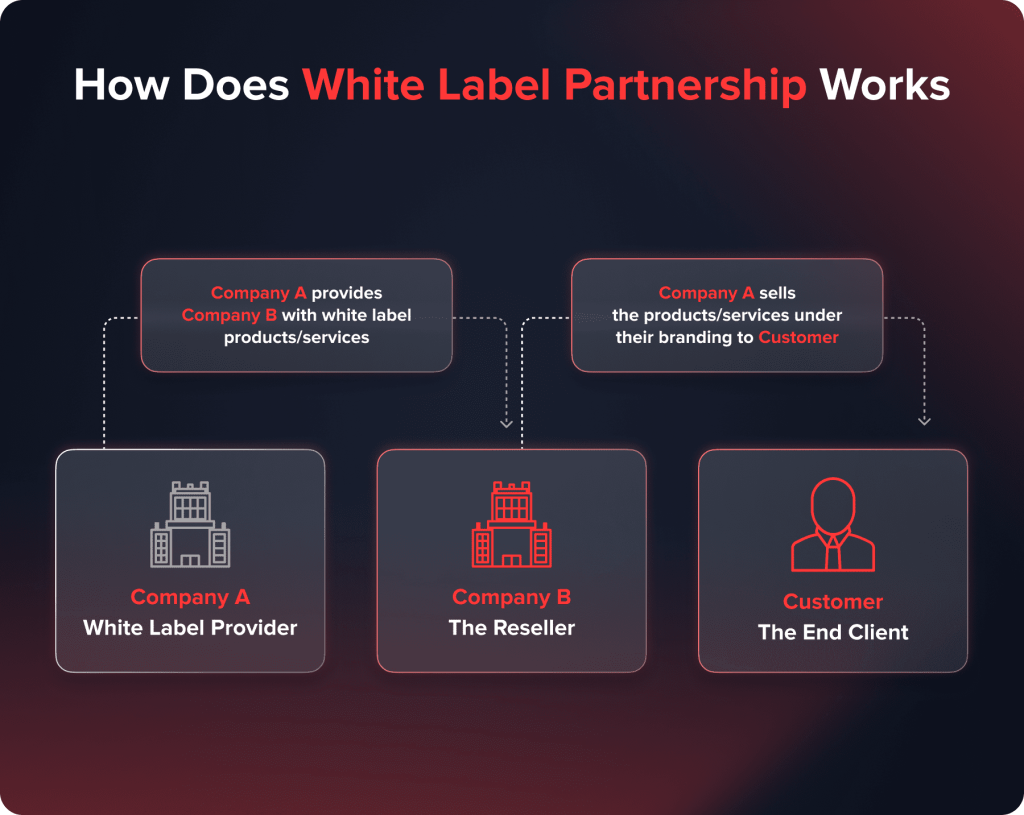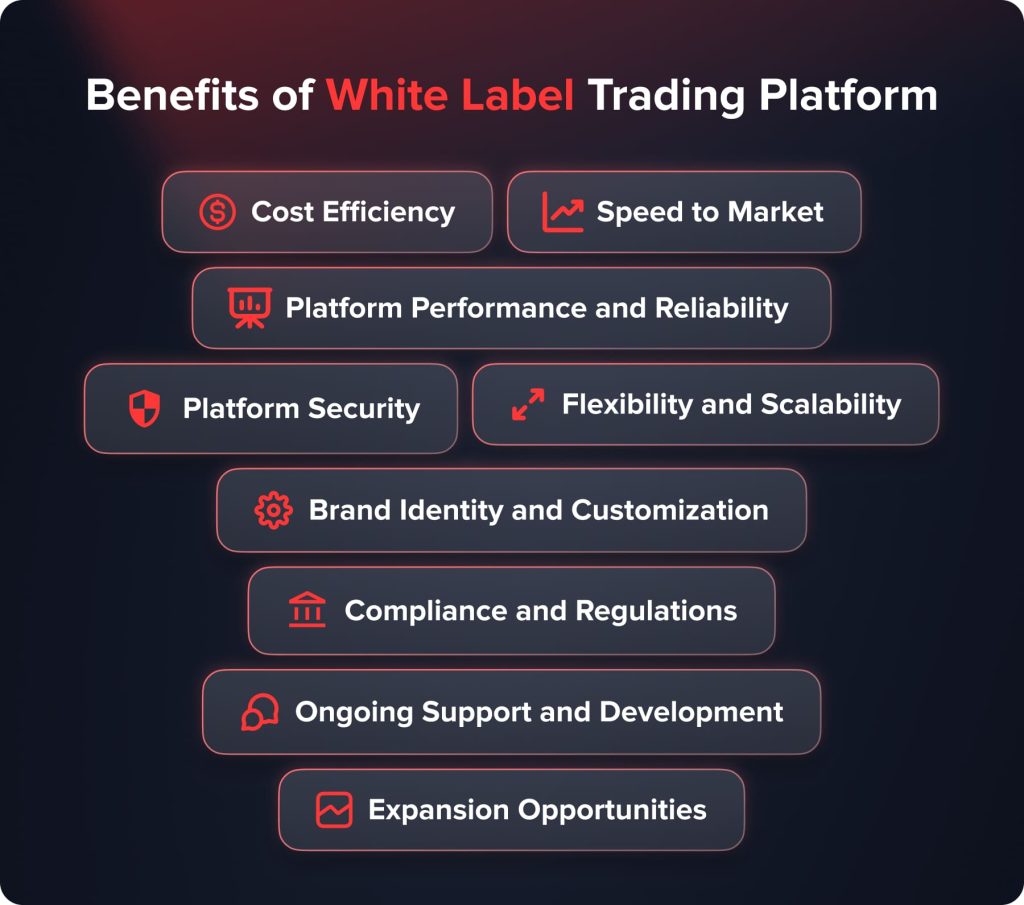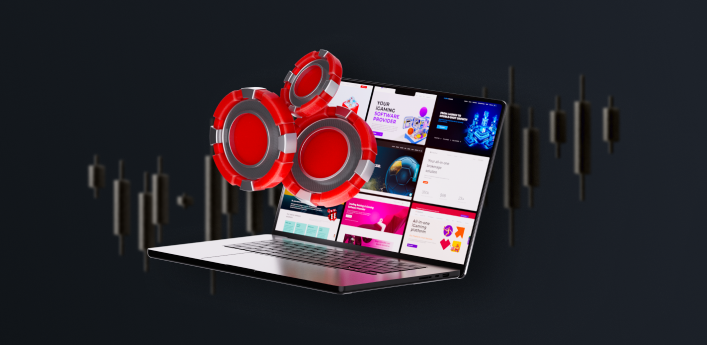
White Label Trading Platform: What Is It And How It Works?
Contents
In the quickly changing world of finance, everyone is on the lookout for quality customizable solutions for starting their own brokerages. Utilizing a white label solution has become an extremely popular choice for many prospective business owners, allowing them quick market access without the through-the-roof costs associated with developing a proprietary system. For those not familiar with it, a white label system is a completed and ready-to-go product developed by a third-party company. The beauty of this arrangement is that you can brand the product as your own. This article will dive deeper into the white label concept and highlight its advantages.

White Label Explained
Business owners looking to enter the financial market are now taking advantage of the white label (WL) trading platform more than ever. A WL trading platform is a complete and comprehensive software solution created specifically for the financial market. These platforms are designed by specialized companies with a deep understanding of and expertise in the trading world. Prospective brokerage owners are able to buy these plug-and-play solutions, brand them, and market them to their clients as their own proprietary platform. This ability to bypass the expensive stage of developing and testing a platform from scratch and move on to customization and branding is one of the main drawing points for many firms.
It should be noted that the WL trading platform is not limited to mere trading operations but includes a wide variety of trading tools for both novice and experienced traders, including charting tools, various analytical tools, and risk management features. These platforms also include real-time data feeds, allowing trade immediate access to the latest market data, which is crucial when trading in volatile markets, such as cryptocurrency.
WL platforms also include an array of statistics and analytics that traders can use to improve their trading performances. Brokerage owners are able to track their trades, assess performance, better understand market trends, and gather actionable insights from both their customers and the financial markets.
Another attractive draw is the ability of WL platforms to offer a large number of asset classes and financial instruments to trade, including Forex, stocks, cryptocurrencies, and commodities. This allows the brokerage owners to tailor their product offerings to a large variety of clients. Offering a one-stop solution for all of traders’ needs is an effective way to reach a bigger customer base.
A trading platform that is slow, insecure, and unreliable wouldn’t do anyone any good, regardless of the many features it has. The back-end infrastructure of a WL platform delivers security, speed, and reliability. In addition to being able to handle the day-to-day operations of a brokerage, WL products provide excellent opportunities for growth and scalability. As the brokerage’s client base grows and the demand increases, the WL platform allows the brokerage to handle more volume and offer more asset classes without additional expenses or decreased performance.
All in all, the white label trading platform is an excellent option for prospective brokerage owners looking to enter the market quickly without laying out hundreds of thousands of dollars on the development of bespoke platforms. Now, let us look more closely at the key advantages the WL platform provides.
You may also like

Benefits of a White Label Platform
Brokerage owners who opt to go with a WL trading platform reap a plethora of benefits. While creating a bespoke trading platform might seem like a novel idea, there are many strategic benefits to going with an already tried-and-tested platform. Such benefits include:

Cost Efficiency
Opting for a WL solution allows you to save a big chunk of your capital on extensive research and development of a new trading platform. Creating a brand-new trading platform from the ground up demands a high number of working hours and financial outlay, leading to bloated start-up costs. Instead of using the funds toward building and testing, a WL platform allows business owners to direct these funds toward more profitable and impactful tasks, such as marketing and client acquisition.
Speed to Market
Another sizeable advantage of using a WL solution is the speed to market. Firms are able to launch their brokerages in a fraction of the time that it would take to develop a proprietary platform in-house. Typical, depending on the chosen WL solution, a brokerage can go live in as little as two weeks. Such a rapid deployment of a brokerage is crucial in fast-paced financial markets, where the ability to react and capitalize on market trends is an integral part of a brokerage’s profitability.
Platform Performance and Reliability
One of the most important factors in acquiring new clients and retaining clients is the performance and reliability of the platform. WL platforms are built and developed by experienced financial developers who understand the needs and challenges of the financial markets. Hence, these platforms are tried and tested, built on infrastructures that guarantee performance and reliability. Thus, brokerages can be assured of the utmost customer satisfaction.
Platform Security
In the world of finance, where large amounts of sensitive data, such as social security numbers, bank account numbers, and credit card numbers, are processed and stored, security is often the number one customer demand. Thus, WL solutions are integrated with the latest advanced security features, including data encryption, two-factor authentication, and constant, consistent security updates. Therefore, choosing a WL solution allows the brokerages to ensure the protection of clients’ data, as well as comply with numerous regulatory requirements as it relates to security.
Flexibility and Scalability
As time passes and the brokerage receives more exposure and more clients, expansion is necessary in order to handle larger volumes of trades and more significant stress on the trading system. WL platforms are designed with scalability in mind, meaning that the brokerage has the option to add new features, provide support for more asset classes and various financial instruments, and increase its capacity. This ensures a seamless, interruption-free environment for the clients as the brokerage continues to expand.
Compliance and Regulations
One of the major challenges all brokerages face is the complex world of financial regulations and various regulators. Navigating all the various requirements and demands can be a time-consuming, expensive task, especially if violations are found and fines are issued. WL solutions usually include compliance features that adhere to international, as well as local, regulations. Such features include AML protocols, risk management, and reporting capabilities. Having a solution that provides for such features reduces the legal and financial risks, allowing the brokerage owner to focus on profitability.
You may also like

Brand Identity and Customization
A brand is a crucial part of any business, allowing business owners to build loyalty and recognition among customers and the general population. Having an individual brand enables the brokerages to to stand out in a crowded market and plays a significant role in attracting and expanding the client base. While WL trading platforms come as a plug-and-play solution, they still allow for extensive customization options. This way, the brokerages can customize and tailor the interface and all the functionalities to their and their clients’ preferences. This includes the customization of logos, color schemes, and the overall design aesthetic.
Ongoing Support and Development
When partnering with a WL provider, the brokerage does not simply get the product but also provides ongoing support in all aspects of the platform, including technical, operations, and regulatory. This includes support and training for the firm’s employees, as well as ongoing support in order to resolve any issues quickly and efficiently. Furthermore, with new technology coming to the fore, the WL provider integrates these into the platform, consistently updating it with improvements and upgrades.
Expansion Opportunities
With such a reliable, scalable platform with numerous features and security protocols, brokerages are well-prepared for expansion into new markets. WL platforms support multiple languages and currencies, allowing the firms to attract customers from all over the world. The fact that the platform can quickly add and support new financial instruments and products means that brokerages can quickly adapt to customer demand and market trends.
White Label vs. Proprietary Trading Platform
When establishing a brokerage, one of the most significant decisions is whether to develop your own proprietary platform or utilize a white label solution. Here is how the two stack up against each other side by side:
| Factor | White Label Platform | Proprietary Platform |
| Development Cost | $25,000 and higher + monthly fees | $150,000+ initial investment, ongoing R&D expenditures |
| Time to Market | 2-6 weeks (plug-and-play) | 6-12 months (full development cycle) |
| Customization | Branding, UI/UX adjustments, feature add-ons | Full control over design, but additional time and cost |
| Maintenance | Handled by WL provider (updates, bug fixing, security patches) | Needs in-house staff (developers, IT staff, compliance officers) |
| Compliance Burden | Pre-integrated tools (AML, KYC, reporting) to cope with regulations | Must develop compliance tools from scratch, high legal overhead |
For most startups, the white label offers faster time to market and reduced risk. Proprietary platforms are typically only an option for large, established brokers with deep pockets.
White Label Trading Platform Costs: Initial and Ongoing Fees
One of the most sought-after questions by new brokers is: “How much does a white label trading platform cost?” The answer depends on the provider, package, and add-ons you choose. For Quadcode, it is an initial setup charge plus an ongoing service charge.
Initial Setup Charges (One-Time)
- Basic: $25,000
- Advanced: $37,000
- Full: $50,000
- Prime: $90,000
These tiers differ by asset coverage (OTC only vs. OTC + Real), mobile apps (iOS/Android are part of Full & Prime), and levels of UI customizations.
Monthly Fees
- Up to $50k PnL: $10k–$12k flat fee (tier-based)
- Above $50k PnL: revenue-share model (25% down to 17.5% as PnL rises above $1M).
Add-On Features (Optional)
Some features can be bought for extra setup + monthly fee, including:
- Bot API: $15k setup + $500/month
- Tournaments: $7.5k first-off + $1k/month
- Islamic Accounts: $2.2k first-off + $350/month
- Public Chats: $2.5k first-off + $500/month
This modular system enables brokers to control costs by adding only what they need.
| Cost element | Range |
| Setup Fee | $25k – $90k (one-time) |
| Monthly Fee | $10k – $12k (flat, up to $50k PnL) |
| Revenue Share | 25% -> 17.5% (scales with PnL above $50k) |
| Add-Ons | $750 – $15k setup + $300 – $1k monthly |
Typically, brokers allocate $25k-$50k setup and $10k-$15k month, based on expansion and features selected.
Must-Have White Label Forex Platform Features
When a white label forex trading platform is selected, there are features that are needed to provide smooth transactions, customer satisfaction, and long-term expansion. Here are the must-have elements to look for:
- Multi-Asset Support – Allows brokerages to offer forex, stocks, crypto, and more, often combined with dedicated broker CRM systems to manage client data and engagement.
- Mobile Trading Apps (iOS & Android) – Traders today expect easy access to markets on smartphones and tablets.
- Liquidity Integration – Direct access to Tier-1 liquidity providers for tight spreads, deep books, and fast execution.
- APIs & Third-Party Integrations – Open APIs to integrate with CRMs, payment gateways, KYC/AML software, and marketing software.
- Risk Management Tools – Intrinsic dealing desk controls, exposure monitoring, and margin management to secure the broker.
- Advanced Charting & Analytics – Technical indicators, drawing tools, and performance dashboards for both client and broker.
- Compliance & KYC/AML Features – Pre-integrated software to comply with local and international requirements (AML, reporting, audits).
- Scalability & Customization – New asset classes, increasing the user capacity, and full branding of the platform.
- Security Infrastructure – Data encryption, two-factor authentication, and regular audits to protect client funds and information.
- 24/7 Support & Updates – Technical support on a continuous basis and regular updates to stay ahead.
You should aim for a white label solution that includes all these features out of the box, without having to invest in business growth instead of infrastructure.
Case Study: Launch a Brokerage in 30 Days
To see how a white label solution works in practice, consider that of a new brokerage company that wants to enter the Forex business but does not have the resources or time to build an in-house platform.
- The Challenge: It would have cost them over $150,000 and at least 9 months of development to build a trading platform from scratch.
- The Solution: They opted to partner with a white label vendor. The team bought a package supporting multiple assets, mobile apps, built-in CRM, and compliance software.
- The Process:
- Paid a $37k setup cost.
- Customized the platform with their name, color scheme, and UI layout.
- Incorporated ready-made payment processing systems and KYC authentication.
- Completed platform testing in less than two weeks.
- The Results:
- Went live in 30 days.
- Kept upfront development costs by ~70%.
- Achieved their first 500 active traders during the first quarter.
- Scaled up without worrying about infrastructure or compliance shortcomings.
This example shows why white label platforms are so attractive: they make it possible for new brokerages to launch quickly, control costs, and focus on growth rather than software development.
How to Choose the Right White Label Provider
Not all white label solutions are created equal. Before signing a contract, evaluate providers carefully to avoid costly mistakes. Here’s a checklist of key criteria to consider:
| Criteria | What to Look For | Why It Matters |
| Technology Stack | Modern architecture, low-latency execution, APIs for integrations | Provides stability, speed, and flexibility for your brokerage |
| Regulation Readiness | Pre-integrated KYC/AML, reporting tools, licensing guidance | Keeps you in line and out of fine trouble |
| Support & Training | 24/7 technical support, employee onboarding assistance, employee training | Reduces downtime and lowers your learning curve |
| Scalability | Can add assets, accommodate more clients, go worldwide | Avails you not to have to change platforms when you grow |
| Cost Transparency | Transparent setup fees, monthly fees, and revenue-share terms | Prevents surprise expenses and facilitates proper budgeting |
| Customization Options | Branding, UI/UX modifications, addition of features | Lets you stand out in a crowded brokerage setting |
| Client Reviews & Case Studies | Testimonials, references, track record proven | Asserts reliability and creates confidence in your decision |
A solid provider must excel on all of these fronts. The lack of one or more would result in higher costs, compliance problems, or client loss down the line.
Integration with MT4/MT5 and Other Important Tools
For most brokers, MetaTrader 4 (MT4) and MetaTrader 5 (MT5) remain the industry norm for trading terminals. A strong white label broker solution must be easily integratable with the same, in addition to other important systems.
This is what to expect:
MT4/MT5 White Label Access
- Branded MT4/MT5 platforms with your company name.
- Full back-office management, including user accounts, reporting, and access control.
- Access to proven trading infrastructure utilized by millions of traders worldwide.
CRM & Back-Office Systems
- Pre-integrated CRMs for managing leads, clients, and affiliates.
- Automatic onboarding with KYC/AML verification tools.
- Real-time monitoring of deposits, withdrawals, and client activity.
Liquidity Providers
- Direct Tier-1 liquidity pool access.
- Low spreads, fast execution, and deep order books.
- Capability to offer several applicable asset classes (Forex, stocks, crypto, CFDs, commodities).
Payment Gateways & PSPs
- Facility for 170+ pre-integrated payment service providers (PSPs).
- Facility for cryptocurrency, credit card, and local banking.
- Capability to introduce new PSPs if needed.
Risk Management Tools
- Integrated dealing desk controls to handle exposure.
- Real-time monitoring of client risk and broker P&L.
Possessing a white label provider which includes MT4/MT5, CRM, liquidity, and payment systems saves time and money. It enables your brokerage to start more quickly while still giving traders the familiar tools they already know.
Common Mistakes When Choosing a White Label Trading Platform
Though white label alternatives make opening a brokerage easy, many new businesses make the same mistakes. Avoid these mistakes to cut costs and credibility:
Choosing the Cheapest Provider
- An inexpensive setup fee usually translates to substandard infrastructure, reduced functionality, or poor support.
- This ends up costing more in lost business and hidden expense in the long term.
Forgetting Compliance Functionality
- Reducing KYC/AML modules or reporting options may be faster, but it creates compliance hazards.
- Fines or license suspensions can cripple a brokerage before it even grows.
Overlooking Liquidity Integration
- Without access to Tier-1 liquidity, traders face wide spreads, slippage, and poor execution.
- This directly impacts trust and client retention.
Skipping Scalability
- Some platforms perform well with a few hundred users but struggle with thousands.
- Lack of scalability means you’ll eventually need to migrate – an expensive, disruptive move.
Neglecting Customization & Branding
- A generic platform looks like hundreds of others available.
- Limited branding lowers confidence and increases the challenge to differentiate.
The best practice is to weigh providers for long-term growth, regulatory compliance, and client experience, not initial cost or speed.
Regulatory Considerations for White Label Brokerages by Region
Compliance is likely the most critical component of running a brokerage. White label operators can offer you the technology, but you are still going to have to comply with local laws. A very brief summary of key regions is provided below:
European Union (EU)
- The EU member state brokers are subject to ESMA compliance, including leverage limits, investor protection, and reporting obligations, all supported by strict KYC processes that safeguard financial transactions.
- Licensing is usually obtained from CySEC (Cyprus) or other EU regulatory bodies, enabling passporting across EU nations.
United States (US)
- US is a highly regulated market.
- The brokers have to register with the CFTC and become a member of the NFA.
- Large capital requirements and reporting needs make it hard for smaller brokerages.
United Kingdom (UK)
- Regulated by the FCA, which has strict supervision and high transparency levels.
- Brexit means double licensing from the EU, but the UK is still a reliable hub for international brokers.
Offshore Jurisdictions (e.g., Seychelles, Belize, St. Vincent)
- Lower fees, quicker licensing options.
- More leverage and advertising flexibility.
- Served as a launching pad by newcomers to the brokerage field, but less well-known among experienced traders.
Asia (Singapore, Hong Kong, Labuan)
- Singapore and Hong Kong offer very prestigious licenses, which require a lot of capital.
- Those in early stages like Labuan (Malaysia) offer less strict regulatory conditions at lower entry points.
Before launching, always verify the regulatory requirements in your target market. A good white label provider can integrate KYC, AML, and reporting tools, but obtaining the correct license is ultimately your responsibility.
Steps to Launch a Brokerage Using WL Provider
While the process of launching a brokerage with a WL solution does simplify the process, there are still several stages and numerous steps that must be taken. These steps are considered in more detail below:
Selecting the Right Provider
The most pivotal and crucial decision is selecting the right provider for your needs and your brokerage. The first thing that needs to be done is to evaluate and study the provider’s track record and reputation. Make sure to research the case studies, client testimonials, and industry reputation to gain a better and deeper understanding of the provider’s reliability. Take note of how the provider was able to customize the solutions for various clients, how they were able to meet their needs and resolve issues and challenges. Look at how long the provider has been serving the market and its experience. A provider that is able to demonstrate longevity is likely safer and will be able to meet your needs.
Consider the technology and its capabilities that the provider uses. Make sure the platform is able to handle a large volume of traders with low latency. Timely execution of trades is absolutely vital for any brokerage that wants to succeed in the financial world. Also, consider the platform’s capability to integrate third-party software, tools, and services.
Assess the provider’s commitment to constantly improving the platform with timely updates in order to integrate new technologies and elements. Evaluate the support offered by the provider. Is it available 24/7? Is it comprehensive? Are several contact methods available, such as phone, chat, and email? Research the training programs the provider has to help your team fully utilize the platform.
As already mentioned, security is a vital aspect, so make sure to check the protection the provider offers. Ensure the platform uses robust encryption methods to protect customer data, conducts regular audits, and remains compliant with all regulations and laws.
Finally, research the provider’s ability to provide for your scalability needs. Ensure that the performance will not be compromised as the volume of users and volume of trades continues to grow. Also, consider how flexible the provider is as market conditions and business models change, and you should be able to change with them.
Fit Brand Identity
Once you’ve selected a reputable provider, your focus should shift to customizing the platform to fit your brand identity. The first step is integrating your brand’s visual elements. This includes your company’s logo, color schemes, and layout design. This is necessary in order to have a consistent brand across all your products and for all client interactions, which is crucial for developing brand recognition and fostering loyalty among users.
Next, you need to customize the features of the trading platform. In order to do this, you need to think about the trading preferences of your target audience and the strategic goals of your business model. For example, if your aim is customers who are interested in algo trading, then you should ensure that advanced automated trading capabilities are integrated into the platform. Also, consider the specific trade execution rules you want to employ, various risk management tools, detailed reporting features, etc. Make sure you think thoroughly through each feature to make sure you are adding the most to your platform and not wasting money on features that will never be used.
Furthermore, if you are targeting the global market, you want to spend some time on the localization aspect. This includes translating all interfaces into multiple languages to make them accessible to a wide range of clients. Ensure that there is local support and multiple currencies to enhance the accessibility and relevance to different financial markets. However, localization goes beyond simply translating the menus; ensure that your content is relevant to local demand and customs, regulations, and market specifics.
Platform Testing
Before your WL platform goes live, it must undergo rigorous and comprehensive testing to ensure it is functioning well and is reliable once it goes live. The first step is functional testing: a thorough testing and examination of every single platform feature to ensure maximum functionality, things such as executing trades, processing payments, deposits, and withdrawals, and generating various reports. This step allows to identify glitches and bugs and to fix them so as not to affect the efficiency and accuracy of trading operations.
Then comes performance testing to determine the platform’s efficiency and stability in various market conditions. The platform might be fine during times of low market activity but may go haywire during volatile times and when under heavy loads. Performance testing allows the brokerage to ensure the platform can handle peak trading without crashing and going offline.
Security testing is the next vital phase of overall testing. The goal here is to identify and eliminate any potential vulnerabilities. Finally, a user acceptance test is conducted. This test provides actual customer feedback on the functionality and usability of the platform. This will highlight areas that need improvements in either design or features.
Going Live
The final step is actually going live with your platform. This is a critical step and must be planned accordingly to ensure the platform’s success from the outset.
The first step is called the soft launch, making the platform available to a select group of users. This is an important step, as there is a controlled environment to test the platform in real-world conditions. The goal here is to identify any left-over bugs after the testing phase and eliminate them as soon as possible. Monitoring, receiving, and reacting to feedback are crucial in this stage. This will provide the brokerage with valuable insight into the platform’s performance that the developers or the testers can miss.
Once the platform has been released to the public, regular updates are necessary to keep the platform performing well and keeping the customer satisfied and happy. The financial sector is one of the most rapidly evolving sectors in the world, so regular updates and enhancements are crucial to stay ahead of the pack and stand out from the competition. Also, consistent updates allow the brokerage to remain compliant with regulations, as these also frequently change.
Bottom Line
A white label trading platform has become an extremely attractive way for business owners to enter the world of financial trading. The ability to customize and fit its brand, along with the cost-efficiency and advanced features, utilizing a WL platform is a great way to break into the trading world. By selecting the right WL provider and strategically using the services and features that come along with it, prospective brokerage owners can swiftly and efficiently enter and succeed in the financial landscape.
FAQ
A white label trading platform is a third-party, pre-built software solution that a brokerage can rebrand and customize as its own. It is less time- and cost-intensive than building a platform in-house.
Prices vary based on provider and package. Setup fees typically range from $25,000 to $90,000 with recurring monthly fees of $10,000-$12,000 (with revenue share if PnL > $50k). Mobile apps or added features may be additional.
Key benefits are lower startup costs, less time to market (as little as 2–6 weeks), built-in compliance options, and ongoing provider assistance. It allows brokers to focus on customer acquisition instead of platform development.
Yes. There are many suppliers offering white label access to MT4 and MT5, as well as integrations for CRMs, payments, and liquidity providers. That allows traders to get the familiar tools they're already accustomed to.
No. The supplier supplies the technology, but you must obtain the right license in your jurisdiction. Some suppliers also offer pre-integrated compliance features (KYC, AML, reporting) to help address regulatory requirements.
Updated:
October 2, 2025
19 December, 2025
Top 10 White Label Casino Providers 2026
A white label casino is a ready-made online gambling platform that lets entrepreneurs start their own brand without building technology or securing licenses from scratch. In 2026, this model remains the fastest and most affordable way to enter the iGaming market. The leading white label casino providers in 2026 are SoftSwiss, BetConstruct, NuxGame, SoftGamings, FintechFuel, […]



